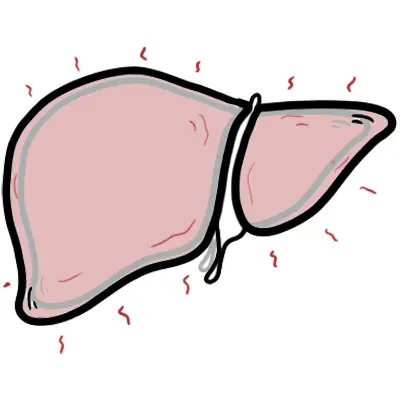Acute Liver (Hepatic) Failure


Acute liver failure is a rare but life-threatening critical illness that occurs most often in patients who do not have preexisting liver disease. Acute liver failure is seen most commonly in previously healthy adults in their 30s and presents unique challenges in clinical management. The clinical presentation usually includes hepatic dysfunction, abnormal liver biochemical values, and coagulopathy; encephalopathy may develop, with multiorgan failure and death occurring in up to half the cases.
Acute liver failure (ALF): is a rare syndrome defined by a rapid decline in hepatic function characterised by jaundice, coagulopathy (INR >1.5), and hepatic encephalopathy in patients with no evidence of prior liver disease
Fatty liver disease: Fat accumulation in the liver as globules. Can be non-alcoholic or alcoholic. Common cause of chronic liver disease and eventually liver cirrhosis
Liver Cirrhosis: irreversible damage or scarring to the liver as a result of advanced liver disease (such as hepatitis) that stops the liver functioning, potentially leading to liver failure.
Aetiology
Determining the aetiology of acute liver failure requires a combination of history taking, laboratory tests, and imaging studies.
Risk Factors
Clinical Presentation of Acute Liver Injury
The presence of jaundice and its relation to the onset of hepatic encephalopathy is important in the assessment of prognosis and further characterisation of ALF.
Clinical Examination of Acute Liver Failure
Asterix: tremor of the hand when the wrist is extended, sometimes said to resemble a bird flapping its wings. Causes include hepatic encephalopathy, uraemic syndrome (renal failure) and pulmonary insufficiency (↑CO2).
| GRADING SYSTEM FOR HEPATIC ENCEPHALOPATHY | |||
| Grade | Mental status | Asterixis | EEG |
| I | Euphoria/depression | Yes/no | Usually normal |
| Mild confusion | |||
| Slurred speech | |||
| Disordered sleep | |||
| II | Lethargy | Yes | Abnormal |
| Moderate confusion | |||
| III | Marked confusion | Yes | Abnormal |
| Incoherent | |||
| Sleeping but arousable | |||
| IV | Coma | No | Abnormal |
Acute hepatic failure is defined by a rapid decline in hepatic function characterised by jaundice, coagulopathy (INR >1.5), and hepatic encephalopathy in patients with no evidence of prior liver disease. Therefore:
| King’s Classification | Features |
| Hyperacute liver failure | Encephalopathy within 7 days of onset of jaundice |
| Acute liver failure | 8-28 days from jaundice to encephalopathy |
| Subacute liver failure | 29-72 days from jaundice to encephalopathy |
Ammnonia levels don’t always correlate with severity of encephalopathy.
Hepatic encephalopathy is a neuropsychiatric disorder in patients with liver dysfunction (personality changes, intellectual impairment, reduced consciousness). This is due to diversion of portal blood into the systemic circulation via collateral resulting in increased about of toxins that are not cleared by the liver. Exposure of the brain to excessive concentrations of ammonia and other toxins can cause neurotoxicity.
Acute liver failure is caused by something. Rule out viral and drug induced causes. Keep in mind the differentials below.
Viral and drug-induced hepatitis are the most common causes of acute liver failure in adults.
| DRUGS ASSOCIATED WITH LIVER INJURY | |
| Drug Class | Examples |
| Herbal and dietary supplements | Body building and weight loss supplements, Chinese herbs and many more… |
| Antimicrobial | Many… |
| Analgesics | NSAIDs, paracetamol |
| Antiepileptic drugs | carbamazepine, lamotrigine, phenytoin, valproate |
| Illicit drugs | MDMA, cocaine |
| Immunomodulatory drugs | Azathioprine, TNF-α inhibitors, methotrexate, interferon-beta |
| Antineoplastic drugs | Flutamide, ipilimumab |
| Antiretroviral drugs | Ritonavir, efavirenz |
| Cardiovascular drugsdrugs | Amiodarone, methyldopa |
| Psychotropic drugs | Duloxetine, chlorpromazine |
Bedside
Serology
Imaging
Initial resuscitation
Regular neurological observations – for patients with rapid progression of encephalopathy/ agitation/ coma and early intubation is recommended to protect airway.
Supportive Treatment
Complications
Intracranial hypertension from severe cerebral edema remains a feared complication and is a leading cause of death worldwide among patients with acute liver failure.
Prognosis
Only 40 percent of patients with acute liver failure recover spontaneously, leaving many in need of a liver transplantation, and even those who do eventually recover are often gravely ill.
Liver transplantation
The decision to proceed with liver transplantation depends upon the probability of spontaneous hepatic recovery. Results in average 1-yr survival rates of about 80%. Transplantation is thus recommended if prognosis without transplantation is worse.
| CRITERIA FOR LIVER TRANSPLANTATION IN PATIENTS WITH ALF | ||
| Factors | Kings College Criteria | Clichy |
| Age | Yes | Yes |
| Cause | Yes | No |
| Encephalopathy | Yes | Yes |
| Bilirubin levels | Varies | No |
| Coagulopathy | Yes | Yes |
UpToDate
NEJM – Acute Liver Failure 2014

Please confirm you want to block this member.
You will no longer be able to:
Please allow a few minutes for this process to complete.
Discussion